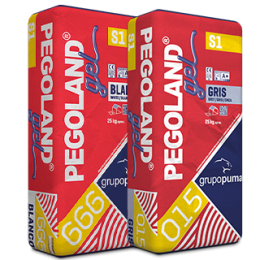 Pegoland Gel S1 C2 TE S1
Pegoland Gel S1 C2 TE S1

Adhesive made of mixed bonding agents with an excellent workability, great flexibility, high adherence, reduced slipping and extended open time. Suitable for the application of interior and exterior pavements and claddings. Suitable for the placing for all kind of ceramic pieces. Specially recommended for façades and big surface pavements and floorings with underfloor heating systems. Suitable for plaster or anhydrite substrates.
Additional information
Composition
Product based on high resistance cement, selected additives and synthetic resins that provide an excellent grip strength, workability and resistance to ageing.
Features and applications
- Creamy appearance with a high consistency so it requires less effort in its application.
- Excellent workability.
- Non slip. Excellent initial adherence.
- Extended open time, it allows the correction of the pieces.
- Deformable. S1 type according to UNE EN 12002.
- No need to wet tiles or substrate thanks to its high water-retaining capacity.
- All kind of ceramic pieces adhesion (double or single fired ceramic, clinker, etc.), porcelain clay, marble, granite and natural stone.
- Suitable for big format pieces.
- Outdoors and indoors applications. Specially recommended for façades.
- Suitable for the tiling of large areas with intense traffic and floors with radiant heating, cooling chambers and overlapping applications.
- Tiling of swimming pools.
- Tiling works on cement based waterproofing layers.
Substrates
- Conventional cement-based substrates, plaster or anhydrite. No primer required.
- Suitable for tiling on all types of laminated plasterboards,
- Marble, granite terrazzo, natural stone substrates and any type of ceramic in interior or exterior pavements and interior claddings.
- Do not apply it on paint.
- Substrates must be resistant, stable, sound and clean, free of dust, demolding agents, organic products, etc.
- All substrates must have the appropriate flatness . Otherwise, smooth down up to 5 mm with the same product 48 hours prior to bonding. In case of greater thickness should be used:
- On floors: Depending on the particular need use.
- On walls: mortars with adequate tensile strength with drying shrinkage already completed.
- In case of hot or windy weather conditions or when applying over absorbent substrates, it is advisable to wet the substrate and wait till the thin layer of water disappears.
- In exterior pavements the substrate should always have a slope of 1% or above.
Instructions for use
- Add water (24%-30%) and mix it manually or mechanically until having a homogeneous and workable consistence.
- Let the mixture stand for 5 minutes and mix it again.
- Spread the mixed product on the substrate with a trowel to a maximum surface area of 2m².
- Spread with a notched trowel to adjust the thickness (see chart).
- Place the pieces on the fresh adhesive, pressing and moving until the grooves are completely crushed and the entire surface of the ceramic is properly adhered, periodically check the stickiness of the adhesive by lifting a previously laid tile, if a non-transfer film appears on the surface of the adhesive, or dehydration of the adhesive, proceed to remove the material and apply a new product.
- Laying the tiles by a double glueing method outdoors, for formats greater than 900cm2, on floors of commercial or industrial use, if there is underfloor heating, when laying ceramic sheets, if using levelling systems or if the tiles have a relief such as that good contact with the adhesive is difficult.
- Respect the construction joints (expansion, shrinkage, fraction, perimeter corner joints) and between tiles (minimum of 2 mm indoors and 5 mm outdoors).
- Joints should be grouted 24 hours after if on vertical surfaces, and 48 hours after if on floorings. Use the appropriate mortar from the MORCEMCOLOR range depending on the type of joint.
NOTE: For better results lay the tiles as soon as possible after spreading the product.
Notched-trowel panel
| TILE FORMAT | NOTCHED TROWEL | BONDING |
| < 100 cm2 | U4 (4 x 4 x 4) | Simple |
| ≤ 450 cm2 | U6 (6 x 6 x 6) | Simple |
| ≤ 900 cm2 | U6 (6 x 6 x 6) U9 (9 x 9 x 9) ó n10 | Double-Simple |
| > 900 cm2 | U9 (9 x 9 x 9) ó n10 | Double |
Maximum weight on vertical surfaces: 50 kg/m²
Cautions and recommendations
- Do not apply below 5ºC nor above 30ºC.
- Do not apply when there is a risk of frost, rain, strong wind or direct sunlight
- Do not use the technique known as by globs.
- Temperatures, ventilation, absorption of the substrates and covering materials may vary the workability and drying timings of the adhesive.
- Under extreme weather conditions (heavy winds or very high temperatures) the adhesive will experience a quicker drying process.
- On flooring and facings with a surface area greater than 50 m2 for interiors, and 30 m2 for exteriors, or for elongated areas over 15 lineal metres, it is recommended to leave separation or sealing joints filled with a deformable material.
- It is advisable to keep a free perimeter expansion joint between the floor and the wall or pillar, hidden by a baseboard (of approximately 5 mm). These joints should be sealed with a deformable material.
- On floorings with underfloor heating, apply when substrate is at room temperature (between 5ºC and 30ºC).
- Underfloor heating systems should be switched off at least 48 hours prior to use and should be switched back on again gradually at least 7 days after installing the flooring and pointing operation.
- Swimming pools can be refilled 7 days after applying the adhesive.
- The water-tightness of a swimming pool must be ensured before using the product on it.
- When using it on plasterboard, ensure the substrate is fixed well to avoid any movement.
- On ceramic pavements (overlays), remove the badly adhered pieces and fill the gaps with mortar the day before the application of the new tiling. Ensure that the old ceramic is free of traces of fats or waxes, if necessary proceed to the milling of the enameled surface until the loss of brightness of the old ceramic. In case of doubt, make a preliminary test to establish the suitability of the solution provided.
- In façades and exterior areas, the application of the material will always be done with mechanic fixation, under any of the following conditions: formats superior to 2400 cm2, a piece with one of the sides larger than 60cm, a weight superior to 40 kg/m2 , or an application above 3m high.
- For pieces reinforced with fiberglass mesh glued on the back, consult the technical department.
- For use on cooling chambers, these should remain switched off until the correct adhesive curing has been obtained, at least 7 days depending on ambient conditions.
- Anhydrite screeds must be perfectly dry (Maximum residual humidity: 0,5%), hard enough and free from dust or superficial grout which, in this case, should be removed by sanding the area.
- When applying slate pieces use suitable adhesives with greater deformability.
- Pieces that may get stains due to their high water absorption should be placed using fast drying adhesives.
Packaging
25 kg plastic-lined paper bags.
Shelf life: 1 year in sealed original packaging, sheltered from weather conditions and humidity.
Technical data
(Statistical data obtained under standard conditions)
| Aspect | WHITE powder |
| Adjustment time | Aprox.30 min. (depending on weather conditions) |
| Paste life | Aprox 2 hours (depending on weather conditions) |
| Initial tensile adhesion strenght | ≥ 1,0 N/mm2 |
| Tensile adhesion strenght after water inmersion | ≥ 1,0 N/mm2 |
| Tensile adhesion strenght after heat ageing | ≥ 1,0 N/mm2 |
| Tensile adhesion strenght after freeze-thaw cycles | ≥ 1,0 N/mm2 |
| Service temperature | - 30ºC a 90ºC |
| UNE-EN 12004 Classification | C2 TE |
| UNE-EN 12002 Classification | S1 |
| Approximate yield | Simple gluing: 4 Kg/m2 |
| Double gluing: 6Kg/m2 |
Note
The instructions for use are given according to our tests and knowledge and do not imply any commitment by GRUPO PUMA nor free the consumer from the examination and verification of the products for their correct use. Claims must be accompanied by the original packaging to allow a proper traceability.
GRUPO PUMA is not responsible, in any case, for the application of its products or constructive solutions carried out by the application company or other parties involved in the process and / or execution of the work, limiting the responsibility of GRUPO PUMA exclusively to the damages directly attributable to the supplied products, individually or integrated in systems, due to failures in their manufacturing process.
In any case, the drafter of the work project, the technical management or the person responsible for the work, or collaterally the application company or other parties involved in the process and / or execution of the work, must ensure the suitability of the products addressing the characteristics of them, as well as the conditions, support and possible pathologies of the work in question.
The values obtained by GRUPO PUMAS's products or its constructive solutions that, as the case may be, are determined by the EN standards or any other regulation that applies to it in each case refers exclusively to the conditions specifically stipulated in said regulation and that are referred to, among others, to certain characteristics of the support, humidity and temperature conditions, etc. without being them required in the tests obtained under different conditions, all in accordance with the relevant regulation.